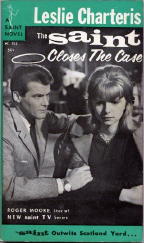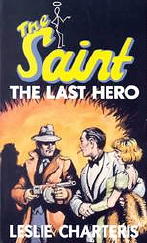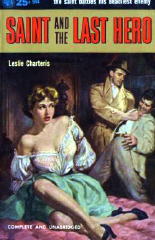Fri 22 Feb 2008
Review: LESLIE CHARTERIS – The Last Hero.
Posted by Steve under Authors , Characters , Reviews[4] Comments
LESLIE CHARTERIS – The Last Hero.
International Polygonics Library; paperback reprint, November 1988. Previous editions: Hodder & Stoughton, UK, hc, 1930. Doubleday Doran & Co./The Crime Club, US, hc, 1931. Plus: Ace/Charter, pb, 1982. Also published as: The Saint Closes the Case, Sun Dial, 1941; Fiction Publishing Co., pb, 1967. And as: The Saint and the Last Hero, Avon #544, 1953.

A fairly complicated publishing history, in other words, and it’s far from complete. But it’s not nearly as complex as the history of The Saint as a character himself. This has generally been considered the second Saint novel, but after reading the Wikipedia entry (under Simon Templar) I am certainly willing to go along with the now accepted chronology: that Meet – the Tiger! was first, and Enter the Saint (consisting of three novellas) was second.
My own exposure to The Saint was through the stories that appeared in every issue of The Saint Detective Magazine when I was in my teens and shortly beyond. The stories came from every time period and in no order whatsoever, so thinking of how The Saint first came on the scene and developed as a character would have been impossible, even if I’d have seriously considered doing so.
From reading The Last Hero at this much later date, and matching my thoughts up with several of the online histories of The Saint, it’s clear in retrospect that Charteris was still tinkering with the character, revising and improvising details as he went along, creating as he did a back story that may (or may not) have stayed constant all the way through the remaining books and collections — nearly a hundred in all.
I’ll not bore you with details, as I’d probably get them wrong, and besides, there’s a book by Burl Barer called The Saint: A Complete History in Print, Radio, Film and Television 1928-1992. (MacFarland, 1992, 2003) that if you’re interested, will get them right. I don’t have a copy, and I will have to get one.
There is also a humongous website devoted only to The Saint that deserves more exploring than I’ve had a chance to do so far.

You may remember the IPL cover to the left as one that has appeared here before. The cover from Avon edition (below right) features Patricia Holm, the love of Simon’s life, fairly prominently. The third one (above right) is from a set of Saint novels that came out when the Roger Moore TV show was playing in the US.
I don’t particularly believe that the title The Saint Closes the Case is apt at all, since the villain, a wealthy arms dealer named Dr. Rayt Marius, manages to survive, only to appear in a few more of the Saint’s adventures, along with his patron, the brutally ambitious Crown Prince of some small unnamed European country.
I said brutally ambitious, and I meant it. In 1930, the clouds of war were beginning to form once again, and it was easy for readers of the day to believe that ruthless profiteers like Marius and the Prince did for a fact exist. Once Simon Templar learns of a mad scientist’s new invention, a veritable death ray machine, he knows that if it were to fall into the wrong hands, or even the right hands, the world would not be likely to survive.
The solution? Kidnap Professor Vargan, confiscate his plans, persuade him to destroy his weapon – or suffer the consequences. There is no bluff on The Saint’s part. He may have his usual devil-may-care attitude about him, but he’s not joking. He and his small group of comrades in arms are deadly serious.
This group of friends includes the previously mentioned Patrica Holm, who gets kidpanned in return, to The Saint’s dismay; Roger Conway, new to the business and prone to error; and Norman Kent, the titular hero:
From the prelude, page 13: “…and it is also the story of one Norman Kent, who was his friend, and how in one moment in that adventure held the fate to two nations, if not of all Europe, in his hands; how he accounted for that stewardship; and how, one quiet summer evening, in a house by the Thames, with no melodrama and no heroics, he fought and died or an idea.”
From Caroline Whitehead and Geroge McLeod, Knights Errant of the Nineeteenth and Early Twentieth Centuries, Chapter 5:

Heady stuff that, then and now, although there are things here about which the reader is not totally aware while the book is in progress. [Nothing essential, but to ease my mind, please forget that you just read it.] After a slow beginning – as the author sorts out his primary character’s affairs, for perhaps the benefit of himself as much as more the reader – this is an adventure nearly without equal. The prose simply sings. On his way to rescue Pat, taken from pages 152-153:
“Other drivers cursed him; two policemen called on him to stop, were ignored, and took his number; he scraped a wing in a desperate rush through a gap that no one else would ever have considered a gap at all; three times he missed death by a miracle while overtaking on a blind corner; and the pugnacious driver of a baby car who ventured to insist on his rightful share of the road went white as the Hirondel forced him on to the kerb to escape annihilation.
“It was an incomparable exhibition of pure hogging, and it made everything of that kind that Roger Conway had been told to do earlier in the evening look like a child’s game with a push-cart; but the Saint didn’t care. He was on his way; and if the rest of the population objected to the manner of his going, they could do one of two things with their objections.
“Some who saw the passage of the Saint that night will remember it to the end of their lives; for the Hirondel, as though recognising the hand of a master at its wheel, became almost a living thing. King of the Road its makers called it, but that night the Hirondel was more than a king: it was the incarnation and apotheosis of all cars. For the Saint drove with the devil at his shoulder, and the Hirondel took its mood from his. If this had been a superstitious age, those who saw it would have crossed themselves and sworn that it was no car at all they saw that night but a snarling silver fiend that roared through London on the wings of an unearthly wind.”
If you can’t read that without getting the least bit of thrill, please try taking your pulse again.
[UPDATE] 02-23-08: I thought you might like to see this:

February 23rd, 2008 at 7:09 am
Thanks for mentioning my book, THE SAINT: A COMPLETE HISTORY …
Yes, you should get a copy of it…and I think you will get a kick out of it. Leslie Charteris got a kick out of it..in fact, he thanked me by buying me lunch in Surrey two weeks before he passed away. He was my literary inspiration…as you may know, I wrote an original Saint novel CAPTURE THE SAINT, authorized by the Estate of Leslie Charteris..it is rare…collectors edition..but there may be a third printing soon.
Thanks again!
Burl Barer
burl@burlbarer.net
February 23rd, 2008 at 8:50 am
Burl
I’ll go order it now, as soon as I finish typing this. This was the first Saint story I’d read in many years, and as I hope you can tell, I enjoyed it immensely.
And yes, I’d already checked out Capture the Saint, the novel you wrote, even before you left your comment above. I discovered that copies can be found online for less than three figures, but not by much. Ouch. A new printing would be good news all right!
Best
— Steve
February 23rd, 2008 at 2:37 pm
I’m just one of the millions with cherished boyhood memories of the Saint. I’m also fortunate enough to have a box of the books in the basement — mostly British H&S Yellow Backs — into which I don’t dip often enough. (Where does all the time go?)
Loved your quote here. Even today, a genre writer creating a series character who is a bit of a rebel can do no better than look to Charteris for marvellous pointers on how it should be done.
February 11th, 2009 at 3:07 am
I guess it falls to me to mention that The Last Hero (The Saint Closes the Case) is the opening book in what is often known as the Saint Trilogy, which recounts his battle with Dr. Ryatt Marius and his involvement in Ruritainian politics. The second book is a milestone in the series, Knight Templar (The Avenging Saint), as it’s the one where the Saint saves the King from an assassination planned by Marius and gets a royal pardon (much to Inspector Teal’s annoyance) so that he is no longer actively wanted by the law — though often suspected. The final book, Saint’s Getaway (Getaway)finds him taking the Crown Prince on in his Ruritanian kingdom and barely escaping with his head. Getaway was filmed as The Saint’s Vacation. The first two books appeared in 1930, and Getaway in 1932.